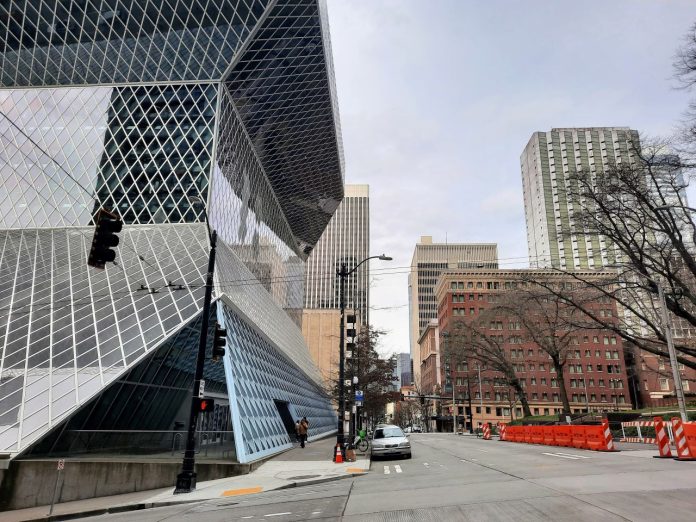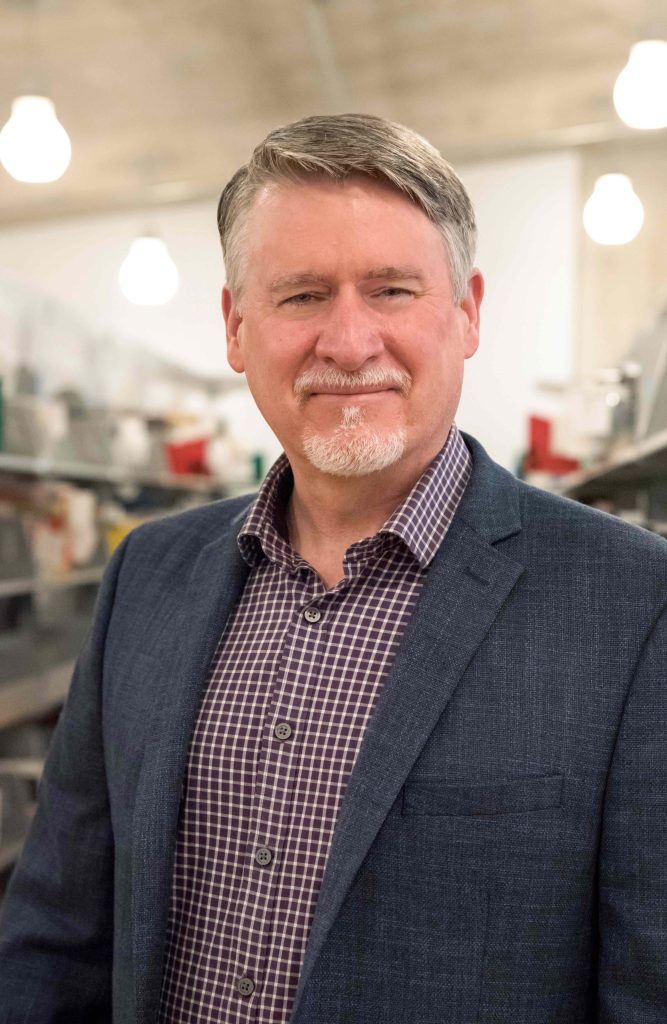From robotic kiosks to essential and safe third places, Seattle Public Library charts a path to the future.
The Seattle Public Library, the city’s jewel of a public library system, is engaged in a strategic planning process. For over a year, Chief Librarian Tom Fay has been listening to community input set to shape the next decade of the system. It’s not going to be an easy time, as laid out in a vision document prepared by the consulting group Houston Foresight. Libraries have become a focus of cultural debates, safety issues arose from the pandemic, and the ever looming recession destabilizes library funding.
I talked with Tom Fay, Chief Librarian for Seattle Public Library about the shape of strategic planning in this atmosphere. Our discussion has been edited for length and clarity.
Ray Dubicki: I don’t know that a lot of people understand what a chief librarian does. Is that any different from an agency head anywhere else in the city?
Tom Fay: I guess, technically, it would be the same as the director for any of the other city departments. I think the library is a little unique in that we’re a city department, and in the city charter, we’re also a creature of the state. So there is a little bit of separation there. The library does not report to the executive, we have a Board of Trustees who are appointed with all the policy and fiduciary responsibilities. I also work with our Board of Directors from the Library Foundation, and our Friends of the Library group as well. So a little bit different than most of the directors who don’t have some of those functions.
Coming to the Seattle’s Chief Librarian role, your background came through Henderson, Nevada. Where did you start feeling drawn toward the more management side versus the public facing librarian side?
Fay: Well, I have a long career, 40 years. Thirty of it was in in Nevada. I actually had a lot of experience in the public service realm. I moved on to the IT side, and I was also in the construction, infrastructure management portion. I really saw myself having more interest in administration and management. At that point, I did get the Masters of Library Science degree, and moved forward into that administrative realm of libraries, and ultimately into some of these director roles and chief operations roles that I’ve held as well.
When you talk about the back end of the library, how does that overlap with the Library’s Strategic Planning process? What is the Strategic Direction in a nutshell?
Fay: I look at it as really the framework for how we’re going to provide services, how we’re going to provide programs. And then what are our spaces? You can talk about a library or branch and say, “It should be this.” Well, how do we know that? We want to have a strong framework to help guide where we’re going and also be able to say, hey, let’s check-in. Let’s engage with community a little bit more in some areas to find out if the needs have changed. So yeah, that’s how I really look at it in a nutshell.
My planner brain appreciates the idea of having data and being able to check-in over time to find what’s effective.
Fay: I think that’s what we’re also trying to define in this Strategic Direction. What’s going to have the impact is the outcomes, so you’re going to have those activities and those resources that are going to push toward those impacts. As we actually look at the outcomes, we want to know that they are measurable.
That may be truly data or that may be more qualitative analysis or discussions with a partner that we engage with. You know, for years, libraries, public libraries across the country, prided themselves on saying “we circulate 15 million items.” Okay, that’s cool. But to what end, to whom? Getting deeper into all that we do, the better.
Now, you’re gathering a lot of input from different corners and consultants and staff and library users. What are the gaps that you’re seeing between those groups?
Fay: I think the interesting piece in this has been not as much gap as you think. I think you’re seeing the community organizations, partners that we work with saying, “Yes, we understand this connectedness that you want. But we also understand the library has to have its priorities and staffing needs.” Quite honestly, the community partners are probably right there and the staff are saying the same thing. I think the values we’ve laid out to become a community hub have been resonating with people.
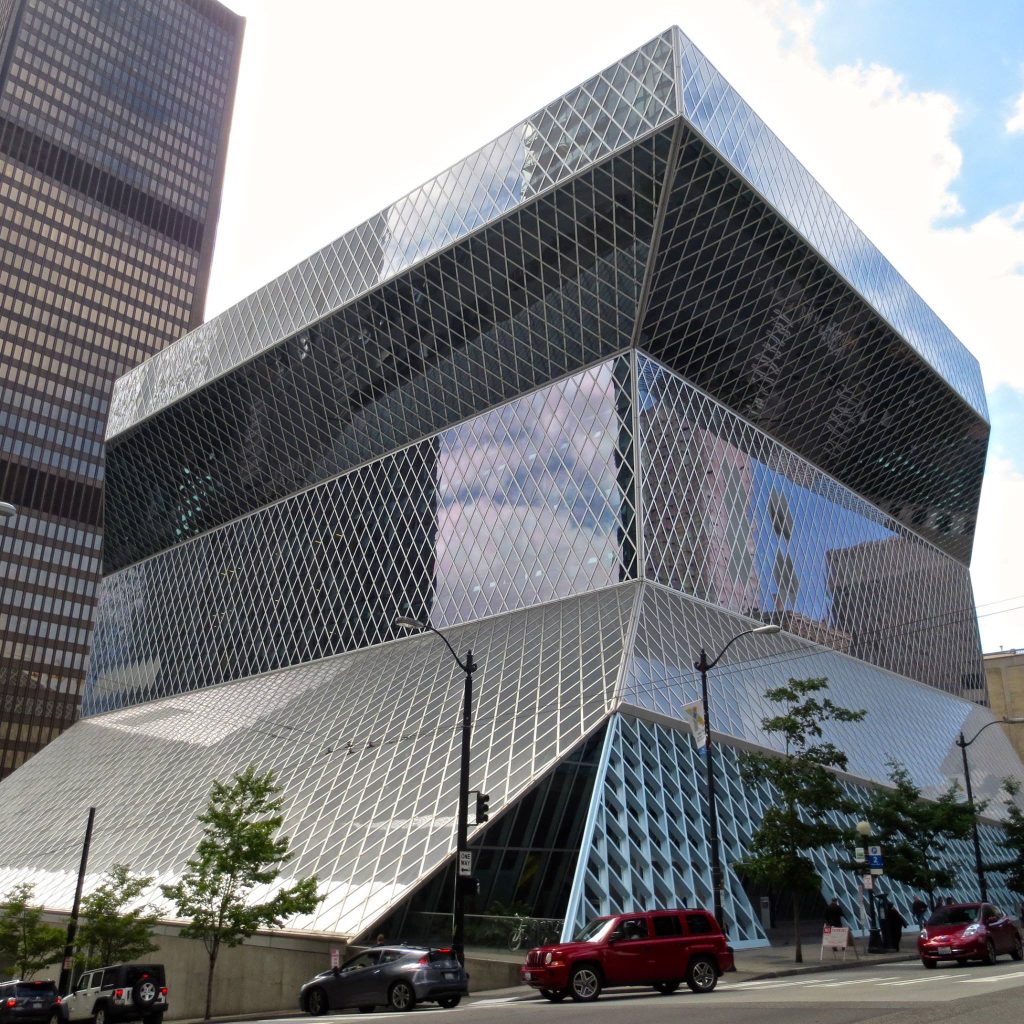
I see you’re in the iconic Central Library by the diamond windows behind you. Did the Central Library give an idea that we have a complete library? We don’t have to worry about that for a long while! We’re all set up!
Fay: I think in any type of massive capital project, like it was for the Libraries for All Levy, that was a pinnacle. The Central Library’s an iconic building known around the world, people still come to visit it, and still want tours and spend time here.
The building’s 20 years old in 2024. The architects of time said, hey, it’s designed to move over time, you will need to change, you’ll have to remodel, you’ll have to do all these things. Now, it’s hard because people say it’s so iconic, you can’t touch it. Well, of course you can. And that’s not just Central, that’s going to be every branch.
Which brings us to the question, is the Strategic Direction looking at more branches or fewer branches?
Fay: We’re not there yet. One of the things that we’re looking at, is what should a branch be? We have some very small buildings, are they the best thing to be “a full branch” or should they fill another need? We’ll also look at alternative services. We have the lockers now. We’re also looking at kiosks – pretty much little robotic vending machines. Can those be out in areas that don’t have branches or customized to specific communities or age groups to serve the need of that physical material that folks still want.
And it’s not as if there’s a lot of unbuilt space in the city. So we also have to be realistic that we may not get the chance to go build another massive building. Positioning to take an interesting opportunity is something we look at. There’s always the question of if the locations are in the right place. The urban village concept is great if urban villages materialize. In some cases they have, and some cases, maybe it didn’t or maybe the community has shifted. All of those things come into play. As the maturity level of the city and of the library progress, we need to be able to say “Yeah, let’s do a little self examination.”
Urbanists think about food deserts, gaps where no grocery stores are located. With the library itself, the branches are pretty evenly spread throughout the city. Is there a different kind of desert or a gap we should be thinking about?
Fay: I think it’s third spaces. You really see the library being, in many cases, that only third space that people can go to that is free space, the place just to be. There used to be a lot more of them, and I think what you see is the library taking on that role in so many areas of the city. Sometimes we have a facility that can accommodate that. And then sometimes we don’t, depending upon size, maybe amenities like air conditioning, things like that. So I think that in almost every US city, you really see that lack of third spaces where people can be and there’s not a pay to play. It’s an important part for libraries, an important role.
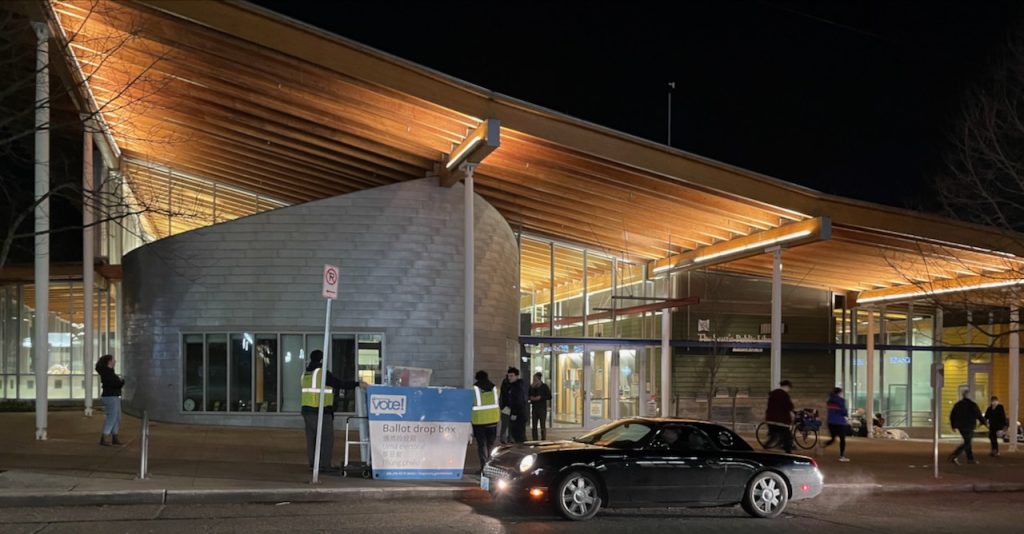
Which, of course, brings us to the safety question. Over the pandemic, when we saw Starbucks shut down and never reopen their bathrooms, the library may be the only place to go. How is the Strategic Direction dealing with the safety issue?
Fay: Well, I think it’s not only the strategic plan, but it’s also the now, the immediate. In our planning, part of it is acknowledging safety is an issue. As Seattle becomes more urban, the problems aren’t going to go away. We know that every US city faces spikes. And we will see the same in Seattle.
The library can’t put its head in the sand. I don’t hide things that we do. Like when we look at having issues in our restrooms from smoking various drugs, we’ve had to put in sensors. That helps us manage, makes sure we talk to people and say, “Hey, things have happened in here. Let’s not have that happen again.”
We need to catch up on our security side of things. We do need to have additional security officers. We have a particular format and style of security today, is that the best suited? We look at our rules of conduct, it’s the same thing. Do we have rules of conduct that actually create conflict that’s unnecessary in our spaces? Those are things that are being reviewed right now.
Acknowledging when some of the things your teams are doing are working and when the greater city helps make areas safer, that’s also a big part of it. It’s truly multifaceted. We acknowledge that we will spend more money on safety over time, without a doubt.
Have you seen a model anywhere else that you think could work for Seattle?
Fay: Not yet, I’ve seen bits and pieces of it. We’re often consulted from across the country for the way we approach security and really bring humanity forward first. Really looking at the behavior and saying, “How can we work with you on that to make sure you’re successful?” It’s an approach now that many tried to do in their spaces.
I think it’s the best approach. Everyone coming in is trying to accomplish something. For those who want to talk about those who are insecurely housed, that is the time people want to point fingers. Guess what, most of time people just want to come in, have a space where they have some quiet peace. Maybe some warmth, or cooling. How is that different than anyone else?
I think we’re by far pretty successful with that. As I remind folks, even in areas where we might have troubles or hotspots, it’s still a small percentage of the human transactions and interactions.
Does the Strategic Direction process draw attention from taking care of these issues today? Is this the right time for a gap in services?
Fay: I don’t see any of the work that we’re doing stopping. So we have been on this path to creating more equitable opportunities for people for a good seven to 10 years now. I think what the Strategic Direction is trying to do is take that to the next level. By being more plan-ful, more intentional, and more resource-focused on those efforts. So I don’t see us having a big lull.
What I see us doing is a lot of things in parallel, from good to better. We need to work on the next Libraries for All levy, having some additional staff capacity, maybe some other resources that come to bear. But that’s all going to be in parallel with the things that we do now to make better options. The rules of conduct underway now. We’ll be finishing by mid-year. So I’m not going to put that on hold. Look at Books Unbanned. How do we fight censorship and control of information? Put more information out there. Why would we stop? There’s no lull.
I think people want identify, “This is going to move to That.” Transformation never works that way. Many things are in parallel as you move through those transformative states. And the Strategic Direction is really a 10-year look at how we get from where we’re at today. We believe we are doing good. Not everything. But we believe a lot of what we do is good.
Then how do we move it to that better and best, really hitting that aspirational state. And that takes many years, and it will most certainly require additional resources and additional prioritization of current resources as we move forward in time. But as that all happens, nothing really stops as we go along.
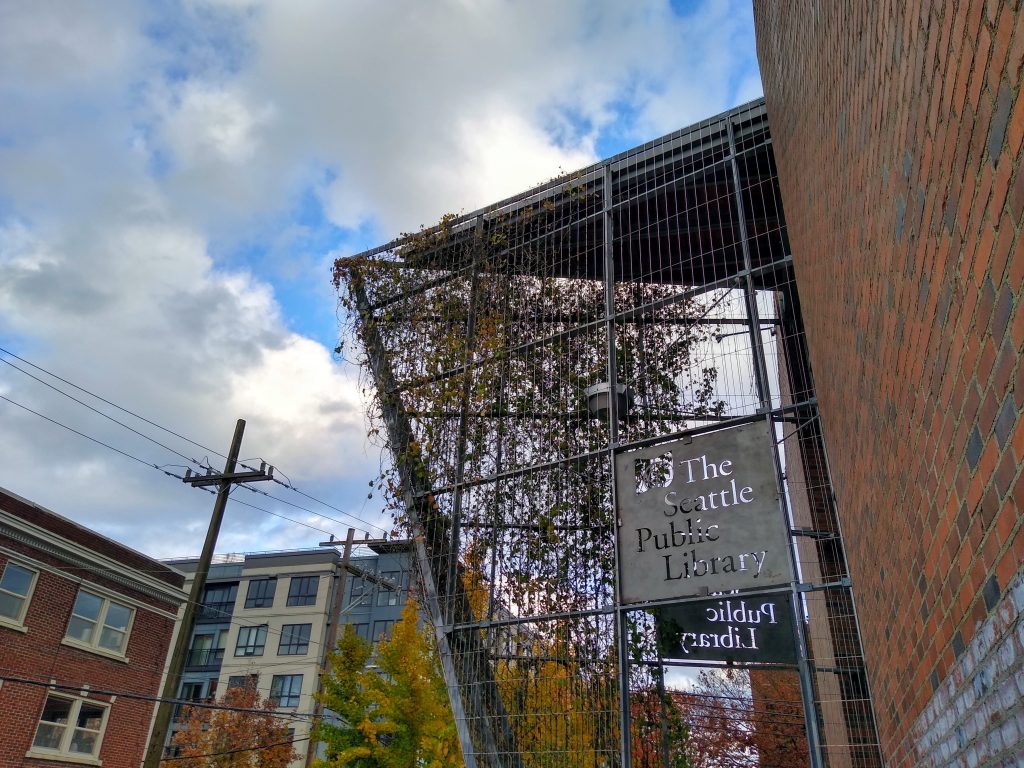
I like the aspirational. What’s your pie in the sky? Beyond if a future library levy passes, but also the library hits the lottery as well.
Fay: When I look at what we’re trying to do with the Strategic Direction, we’re talking about the transformational impact of belonging, and of being a resilient community. That’s everything — that’s from staffing, to those who support us, to the public at large. That is going to create more equitable opportunities for all. If you believe you belong, it’s a better place to start than feeling that you’re an outsider.
I think in my nine years here, I believe it’s something that Seattle has been trying to create. We have a lot of immigrants who come here as well. How do we really make sure that people feel like they belong? How does the staff member coming into the library feel like they belong? How do we look to bring in folks who work or live in these communities who may not have the traditional sense of what libraries are? As we re-craft and re-mould what libraries might be, how do we make sure that we create that sense of belonging if we want diversity, equity and inclusion, like we talk about?
So yes, in my ideal world, we would actually be leveraging all of our networks, all of our partnerships, to really move to that impact of belonging. Really creating a resilient city so that minor little bumps along the way are not going to stop it. Just keep moving and getting better.
Is there something you still look for every time you go into the library?
Fay: Oh, every time I go into the library, I’m looking for what are they doing to activate the space to really engage people of all ages, right? Because I think that is the biggest challenge. We serve everyone from before they’re born, and they’re still in the womb, until the time they pass away. I always look at, is there something in here for everyone? Is there a way for everyone to engage?
Correction: An early version of this article misspelled Tom Fay’s last name. Apologies. We regret the error.
Ray Dubicki is a stay-at-home dad and parent-on-call for taking care of general school and neighborhood tasks around Ballard. This lets him see how urbanism works (or doesn’t) during the hours most people are locked in their office. He is an attorney and urbanist by training, with soup-to-nuts planning experience from code enforcement to university development to writing zoning ordinances. He enjoys using PowerPoint, but only because it’s no longer a weekly obligation.

